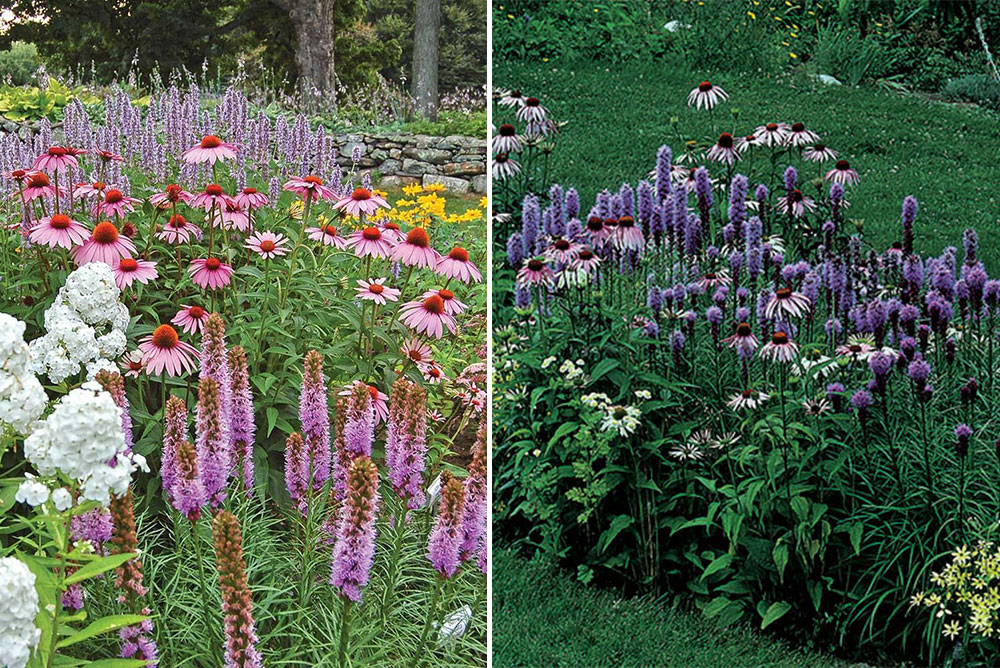
Two pollinator-garden designs suggested by the White Flower Farm catalogue.
By Stephanie Cavanaugh
IT’S TIME to stop daydreaming and pull on your gardening gauntlets.
While it may feel as if we’re lollygagging along, that it’s been spring for a month—roses already!—it’s only now time to get down and dirty.
What a luxurious thing it is to have had such a long, flowery spring, constantly tingled with a threat of a frigid rebound and the destruction of those tender blossoms, the tension adding to the delight. Like duck sauce and mustard.
We’re at the absolute right time to lay in the mulch, contemplate the zinnias and dahlias. The last frost dates are beginning to cascade. In Washington DC, that’s April 21, this weekend. (Although, for those outside the zone, you may have days or even weeks more to wait).
Tender annuals and tropicals, such as lemons and hibiscus, are now beginning to fill garden centers. The better centers put out frost-sensitive plants only when we can be reasonably assured that they’ll live. This is good, if frustrating, for the impatient, or those lucky enough to have a backyard microclimate that can reliably skirt the danger.
If you have your garden plan in hand. Well, ready, set, hoe.
But if you’re waiting for your green or black thumb to turn a bare patch of, let’s be blunt, dirt, into a blooming paradise, and have no plan yet, here’s my advice . . .
Steal.
If you’re like most, the issue will be where to start.
If you have a reasonable working knowledge of plant names and varieties, take a wander through your neighborhood (or an aspirational one) and see what others have done. If you see stuff you like, but haven’t a clue, get an app for your phone, like Picture This, which will identify most plants and give care instructions. Write down what you see—placement and varieties and so forth—and have at it.
I did this 40 years ago, a newbie at gardening in a garden, not a pot on a fire escape. One neighbor had the most breathtaking climbing rose covering the side of the house. I planted a Queen Elizabeth in the same location in my garden and it was spectacular, until the tree grew, blocked the sun, and poof. Similarly, a wisteria caught my eye—just the thing for the garage roof, I thought. And so one was planted. It has yet to bloom. Seems I bought the wrong variety, Chinese wisteria, which blooms (when it blooms) as the vine leafs out, not before the leaves appear, which is what I expected. Ah well, live and learn.
Sometimes a catalogue can be your garden’s buddy.
While I haven’t bought anything from White Flower Farm in decades, it’s a great jumping-off point for those with deep pockets—we’ll get to that. Reliable, with beautiful stock, and excellent hand-holding, the Connecticut-based family-run company has been around since the 1950s, supplying not just plants but entire gardens, acting as your designer.
If you are an experienced gardener you will probably need only look at the photos as an aid to sketching out your design and then shop locally for the plants. Beyond supporting neighborhood resources, there’s a joy to seeing and sniffing the stock.
For the clueless, the WFF website describes entire gardenscapes, which you can buy and plop into your (prepared) beds. The Long Season Hummingbird Garden, for example, includes 15 plants and covers 30 square feet. Among other bloomers, there are salvia, heuchera, monardia, and phlox. Some bloom through fall, others flower at different points between now and then, giving you months of blossoms.
The collection is $189 plus $50 shipping. A pretty penny, one (me) says for some common bloomers. But if you don’t know what you’re doing and want a beautiful garden that you don’t have to fret over . . . well, shell out.
Totally guilt-free for the taking is the Pink Pollinator Garden, which attracts beneficial bugs. It’s already out of stock, as are a number of other preplanned gardens, so filch the basic design with impunity. This one’s such a happy frolic of Barbie-pink plants—movie tie-in! starring phlox, yarrow, coneflower, and bee balm.
Each of the White Flower Farm designs includes a handy diagram so you know where to place each plant so the foliage and flowers are most complementary in size and bloom time. If you’re shopping locally, make note of the height and expected spread of each pot and compare with their selections.
Word of warning. It’s so tempting to load up on spring bloomers, lilacs and cherry trees, peonies and the more ephemeral roses —i.e., not those scentless, ever-blooming, perennially boring, Knock Outs.* If you do, you’ll have only green to show for it come July.
Make sure to add annuals to any collection so you have flowers from now till frost. Stuff them into pots and empty spaces or line the edges of the border, so your eye can dance into winter.
*No offense. I have some too. They have their uses.

Kristen: Also, vegan!
That “duck sauce and mustard” simile is perfection.
Very helpful article.
Thank you.
I’m inspired to “ Ready,set, hoe!”